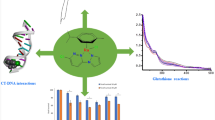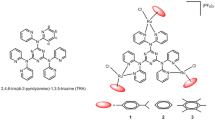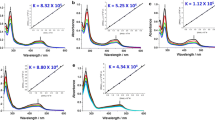Abstract
We report the synthesis, nucleic acid binding and cytotoxicity of the complexes [Ru(terpy)(Me2bpy)Cl]+, [Ru(terpy)(phen)Cl]+ and dinuclear [{Ru(terpy)Cl}2(μ-bbn)]2+ {where Me2bpy = 4,4′-dimethyl-2,2′-bipyridine; phen = 1,10-phenanthroline; and bbn = bis[4(4′-methyl-2,2′-bipyridyl)]-1,n-alkane, with n = 7, 10, 12, 14}. The complexes were isolated from the reaction of the [Ru(terpy)Cl3] precursor with the respective bidentate and di-bidentate bridging ligands. The time-course UV–Visible spectroscopy of the reaction of the mono- and dinuclear complexes with guanosine 5-monophosphate (GMP) showed the movement of the metal-to-ligand charge transfer (MLCT) band to lower wavelengths, accompanied by a hypochromism effect. The formation of the aqua complex and phosphate-bound intermediates in the reaction were detected by the time-course 1H NMR and 31P NMR experiments, which also demonstrated that the complex bound to the N7 guanine was the major product. The UV–Visible and 1H NMR studies showed no evidence of the interaction of the complexes with both adenosine 5-monophosphate (AMP) and cytidine 5-monophosphate (CMP). Cytotoxicity studies of these complexes against a murine leukemia L1210 cell line revealed that the dinuclear [{Ru(terpy)Cl}2(μ-bbn)]2+ complexes were significantly more cytotoxic than mononuclear [Ru(terpy)(Me2bpy)Cl]+. The [{Ru(terpy)Cl}2(μ-bb14)]2+ complex appeared to be the most active (IC50 = 4.2 μM).






Similar content being viewed by others
Notes
The estimated t1/2 values for the [Ru(terpy)(Me2bpy)Cl]Cl-GMP, [{Ru(terpy)Cl}2(μ-bb7)]-GMP and [{Ru(terpy)Cl}2(μ-bb12)]-GMP reactions were 25, 80 and 92 mins, respectively, calculated on the basis of the changes in the absorbance over time at 500 nm. With the excess amount of the mononucleotides used, it was assumed that there was only a small change in the concentration of the mononucleotides such that the reaction followed pseudo-first-order kinetics. The detailed investigation of the reaction mechanism and kinetics is currently underway.
References
Wheate, N.J., Collins, J.G.: Multi-nuclear platinum complexes as anti-cancer drugs. Coord. Chem. Rev. 241, 133–145 (2003)
Galanski, M., Arion, V.B., Jakupec, M.A., Keppler, B.K.: Recent developments in the field of tumor-inhibiting metal complexes. Curr. Pharm. 9, 2078–2089 (2003)
Clarke, M.J.: Ruthenium metallopharmaceuticals. Coord. Chem. Rev. 236, 209–233 (2003)
Bergamom, A., Sava, G.: Ruthenium complexes can target determinants of tumour malignancy. Dalton Trans. 1267–1272 (2007)
Barton, J.K., Lolis, E.: Chiral discrimination in the covalent binding of bis(phenanthroline)dichlororuthenium(II) to B-DNA. J. Am. Chem. Soc. 107, 708–709 (1985)
Morris, R.E., Aird, R.E., Murdoch, P.d.S., Chen, H.M., Cummings, J., Hughes, N.D., Parsons, S., Parkin, A., Boyd, G., Jodrell, D.I., Sadler, P.J.: Inhibition of cancer cell growth by ruthenium(II) arene complexes. J. Med. Chem. 44, 3616–3621 (2001)
Novakova, O., Kasparkova, J., Vrana, O., van Vliet, P.M., Reedijk, J., Brabec, V.: Correlation between cytotoxicity and DNA binding of polypyridyl ruthenium complexes. Biochemistry 34, 12369–12378 (1995)
Wang, Y.-H., Cheng, C.-C., Lee, W.-J., Chiou, M.-L., Pai, C.-W., Wen, C.-C., Chen, W.-L., Chen, Y.-H.: A novel phenotype-based approach for systematically screening antiploriferation metallodrugs. Chem-Biol. Interact. 182, 84–91 (2009)
Ho, M.-Y., Chiou, M.-K., Chang, R.-C., Chen, Y.-H., Cheng, C.-C.: Outer membrane protein OmpF involved in the transportation of polypyridyl ruthenium complexes into Escherichia coli. J. Inorg. Bochem. 104, 614–617 (2010)
Mulyana, Y., Weber, D.K., Buck, D.P., Motti, C.A., Collins, J.G., Keene, F.R.: Oligonuclear polypyridylruthenium(II) complexes incorporating flexible polar and non-polar bridges: synthesis, DNA binding and cytotoxicity. Dalton Trans. 40(7), 1510–1523 (2011)
Li, F., Mulyana, Y., Feterl, M., Warner, J., Collins, J.G., Keene, F.R.: The antimicrobial activity of inert oligonuclear polypyridylruthenium(II) complexes against pathogenic bacteria, including MRSA. Dalton Trans. 40, 5032–5038 (2011)
Pisani, M.J., Fromm, P.D., Mulyana, Y., Clarke, R.J., Heimann, K., Collins, J.G., Keene, F.R.: Mechanism of cytotoxicity and cellular uptake of lipophilic inert dinuclear polypyridylruthenium(II) complexes. ChemMedChem 6, 848–858 (2011)
Davies, N.R., Mullins, T.L.: Substitution reactions of some bis(2,2′-bipyridine) and mixed 2,2′-bipyridine,2,2′,2′′-terpyridine complexes of ruthenium(II). Aust. J. Chem. 20, 657–668 (1967)
Wasylenko, D.J., Ganesamoorthy, C., Koivisto, B.D., Henderson, M.A., Berlinguette, C.P.: Insights into water oxidation by mononuclear polypyridyl Ru catalysts. Inorg. Chem. 49, 2202–2209 (2010)
Concepcion, J.J., Jurss, J.W., Templeton, J.L., Meyer, T.J.: One site is enough. Catalytic water oxidation by [Ru(tpy)(bpm)(OH2)]2+ and [Ru(tpy)(bpz)(OH2)]2+. J. Am. Chem. Soc. 130, 16462–16463 (2008)
Alston, J.R., Kobayashi, S., Younts, T.J., Poler, J.C.: Synthesis and characterisation of rigid +2 and +3 heteroleptic dinuclear ruthenium(II) complexes. Polyhedron 29, 2696–2702 (2010)
Wasylenko, D.J., Ganesamoorthy, C., Koivisto, B.D., Berlinguette, C.P.: Examination of water oxidation by catalysts containing cofacial metal sites. Eur. J. Inorg. Chem. 2010, 3135–3142 (2010)
Adcock, P.A., Keene, F.R., Smythe, R.S., Snow, M.R.: Oxidation of isopropylamine and related amines coordinated to ruthenium. Formation of monodentate imine and alkylideneamido complexes of ruthenium. Inorg. Chem. 23, 2336–2343 (1984)
Nakabayashi, Y., Inada, H., Minoura, Y., Iwamoto, N., Yamauchi, O.: Effects of flexible bridging ligands on DNA-binding of dinuclear ruthenium(II)-2,2′-bipyridine complexes. Inorg. Chim. Acta 362, 869–877 (2009)
Chen, H., Parkinson, J.A., Morris, R.E., Sadler, P.J.: Highly selective binding of organometallic ruthenium ethylenediamine complexes to nucleic acids: novel recognition mechanisms. J. Am. Chem. Soc. 125, 173–186 (2003)
Marzilli, L.G., Kistenmacher, T.J.: Stereoselectivity in the binding of transition-metal chelate complexes to nucleic acid constituents: bonding and nonbonding effects. Acc. Chem. Res. 10, 146–152 (1977)
Bencroft, D.P., Lepre, C.A., Lippard, S.J.: 195Pt NMR kinetic and mechanistic studies of cis and trans-diamminodichloroplatinum(II) binding to DNA. J. Am. Chem. Soc. 112, 6860–6871 (1990)
Baik, M.-H., Freisner, R.A., Lippard, S.J.: Theoretical study of cisplatin binding to purine bases: why does cisplatin prefer guanine over adenine. J. Am. Chem. Soc. 125, 14082–14092 (2003)
Pisani, M.J., Weber, D.K., Heimann, K., Collins, J.G., Keene, F.R.: Selective mitochondrial accumulation of cytotoxic dinuclear polypyridylruthenium(II) complexes. Metallomics 2, 2393–2396 (2010)
Farrell, N.: Polynuclear charged platinum compounds as a new class of anticancer agents. In: Kelland, L.R., Farrell, N.P. (eds.) Platinum-Based Drugs in Cancer Therapy, pp. 321–338. Humana Press, Totowa, NJ (2000)
Morgan, J.L., Buck, D.P., Turley, A.G., Collins, J.G., Keene, F.R.: Meso-[{Ru(phen)2}2(μ-bpm)]4+: a high affinity DNA bulge probe {bpm = 2,2′-bipyrimidine, phen = 1, 10-phenanthroline}. Inorg. Chim. Acta 359, 888–898 (2006)
Morgan, J.L., Spillane, C.B., Smith, J.A., Buck, D.P., Collins, J.G., Keene, F.R.: Dinuclear ruthenium(II) complexes with flexible bridges as non-duplex DNA binding agents. Dalton Trans. 4333–4342 (2007)
Talarico, T., Phillips, D.R., Deacon, G.B., Rainone, S., Webster, L.K.: Activity and DNA binding of new organoamidoplatinum(II) complexes. Investigational New Drugs 17, 1–15 (1999)
Acknowledgments
We acknowledge the financial support of the Australian Research Council. We wish to thank Dr. Carleen Cullinane and Alison Slater (Peter MacCallum Cancer Centre, Melbourne, Australia) for their cooperation and assistance with the cytotoxicity measurements reported in this work.
Author information
Authors and Affiliations
Corresponding author
Additional information
Dedicated to Len Lindoy—colleague, mentor and friend—on the occasion of his 75th birthday
Rights and permissions
About this article
Cite this article
Mulyana, Y., Collins, G. & Keene, R. Synthesis, nucleic acid binding and cytotoxicity of oligonuclear ruthenium complexes containing labile ligands. J Incl Phenom Macrocycl Chem 71, 371–379 (2011). https://doi.org/10.1007/s10847-011-0036-1
Received:
Accepted:
Published:
Issue Date:
DOI: https://doi.org/10.1007/s10847-011-0036-1




